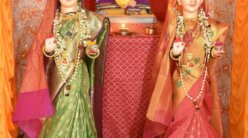Ganesh Festival in Pune: The Manache Ganpati and Their Unique Tradition
Pune’s Ganesh festival is renowned for its century-old traditions, spectacular decorations, and a uniquely spiritual atmosphere that transforms the city every year. The streets come alive with elaborate pandals, themed decorations including floral art and dramatic lighting, and cultural spectacles ranging from mythological tableaus to plays inspired by current affairs.
The Tradition of ‘Manache Ganpati’
Pune is the pioneer of the Sarvajanik Ganeshotsav (public Ganesh festival), having set a precedent in the late 19th century for collective celebration of Ganesh Chaturthi. The heart of this tradition is the ‘Manache Ganpati’, a revered group of five Ganpati mandals that hold an unbroken honor of leading the city’s Ganesh immersion procession for the past 124 years. This order has never changed, and the prestige associated with these mandals is a point of pride for Pune.
Here is a brief overview of the five Manache Ganpati, their significance, and what makes each one special:
1. Kasba Ganpati (Manacha Pahila Ganpati)
-
Status: First and most respected Ganpati in Pune.
-
History: Established in 1630/1636 with roots in the era of Shivaji Maharaj and Jijabai, who saw the idol as a blessing upon resettling Pune post-devastation.
-
Role: Declared “Manacha Pahila Ganpati” by Lokmanya Tilak in 1893, it leads the immersion procession.
-
Location: Kasba Peth, central Pune.
2. Tambdi Jogeshwari Ganpati (Manacha Dusra Ganpati)
-
Status: Second most esteemed Ganpati.
-
History: Housed in the ancient Tambdi Jogeshwari temple, primarily dedicated to Goddess Jogeshwari (gramdevi or village deity) and recognized as a major spiritual hub since the 16th century.
-
Specialty: Known for its traditional red-colored Ganpati idol and dome of silver; plays a significant role in Pune’s spiritual and cultural life.
3. Guruji Talim Ganpati (Manacha Tisra Ganpati)
-
Status: Third in the procession.
-
History: Established in 1887, before Tilak popularized the Sarvajanik Ganeshotsav. Symbolizes Hindu-Muslim unity, as it was founded by both communities together.
-
Specialty: Started in a wrestling ‘Talim’ (arena) and is celebrated as a symbol of communal harmony.
4. Tulshibaug Ganpati (Manacha Choutha Ganpati)
-
Status: Fourth Manache Ganpati.
-
History: Established in 1901 in the bustling Tulshibaug market area.
-
Specialty: The 13-to-15 feet tall idol adorned with 80kg of silver jewelry is famous for creative, thematic decorations that change every year. The mandal was the first in the country to install a fiberglass idol (1975).
5. Kesariwada Ganpati (Manacha Panchva Ganpati)
-
Status: Fifth in the prestigious lineup.
-
History: Started by Lokmanya Tilak in 1894 at Vinchurkar Wada; shifted to Kesari Wada in 1905.
-
Specialty: Played a pivotal role in India’s freedom movement. The venue is closely associated with Tilak’s social and journalistic legacies, and the mandal’s themes often reflect the freedom struggle and national pride.
Additional Highlights
-
Dagdusheth Halwai Ganpati: Not one of the Manache Ganpati, but arguably Pune’s most famous Ganesh temple, beloved for its stunning idol and charitable initiatives. Founded in the late 19th century, the temple draws over 100,000 visitors daily during the festival, making it a must-visit.
-
Other Notables: Pandals like Babu Genu (Navsacha Ganpati), Shrimant Bhausaheb Rangari, and Natu Baug are beloved for wish fulfillment, historical legacy, and extravagant light displays respectively.
The Spirit of Pune’s Ganesh Festival
-
Decor & Themes: Mandals feature extravagant floral decorations, creative lighting, and elaborate themes—from retelling mythological tales to enacting contemporary events.
-
Spiritual & Cultural Experience: From dawn (5AM) till late night, devotees and visitors from all backgrounds flock to these pandals, soaking in the devotional songs, vibrant processions, and community enthusiasm.
-
Historical Importance: Before the British Raj, familial and temple-based Ganesh celebrations were common. In 1893, Lokmanya Tilak transformed Ganeshotsav into a mass public movement to unite Indians and bypass colonial restrictions on assemblies—giving rise to the ‘sarvajanik’ (public) festival tradition that thrives till today.
Visiting Tips
-
Timings: Most mandals and temples—including Dagdusheth—are open from early morning (as early as 5AM or 6AM) until late night during the festival.
-
Location: Most Manache Ganpati are located in or around the heart of Pune, easily accessible on foot or by rickshaw.
-
Processions: The order of immersion procession (visarjan) is strictly maintained: first Kasba, followed by Tambdi Jogeshwari, Guruji Talim, Tulshibaug, and ending with Kesariwada.
Visiting Pune during Ganesh festival is a sensory feast—there is devotion, artistry, music, history, and unity. It’s a time when the entire city comes together to celebrate tradition and community spirit.











